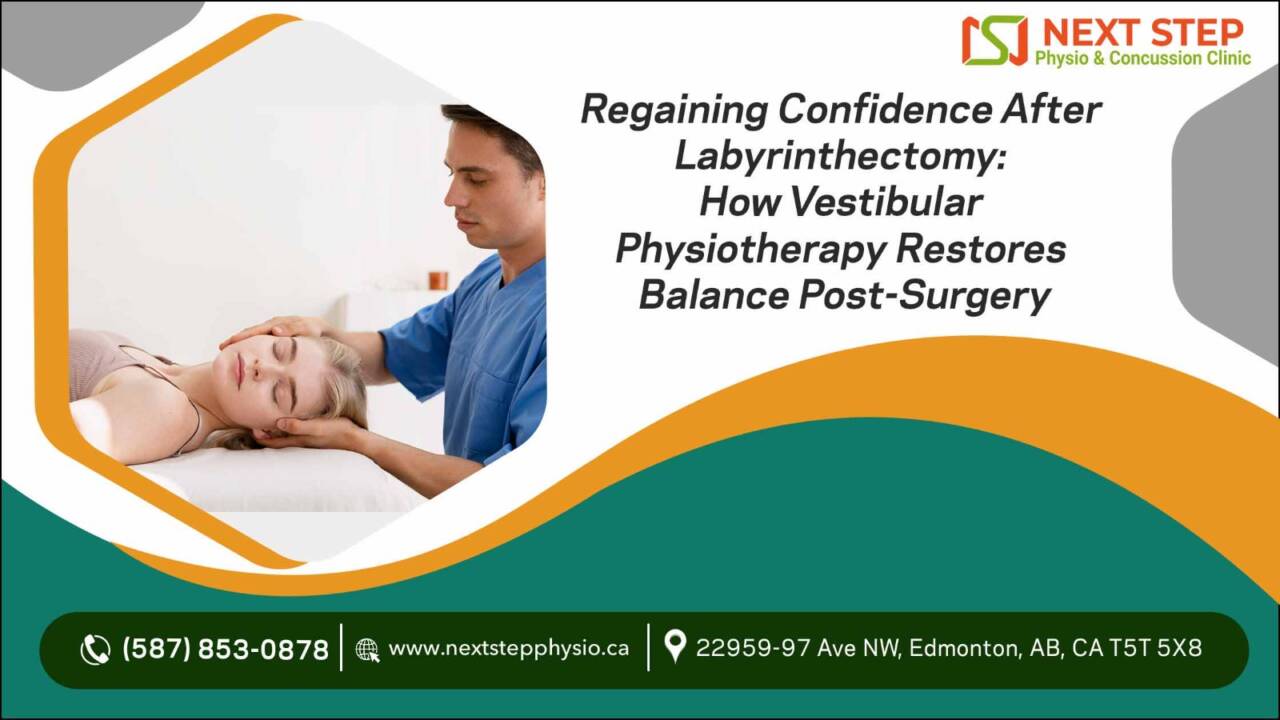HEALTH
Regaining Confidence After Labyrinthectomy: How Vestibular Physiotherapy Restores Balance Post-Surgery

Vestibular physiotherapy post-labyrinthectomy is a specialized rehabilitation approach targeting the vestibular system. It aims to address balance deficits, vertigo, and dizziness resulting from the surgical removal of the labyrinth, a crucial component of the inner ear responsible for balance and spatial orientation. Vestibular physiotherapy in Edmonton helps patients adapt to the altered vestibular function, improve balance, and regain confidence in daily activities.
How Vestibular Physiotherapy Helps in Restoring Balance After Labyrinthectomy?
Regaining confidence after a labyrinthectomy can be difficult because of the substantial influence it exerts on the vestibular system. However, vestibular physiotherapy plays a crucial role in restoring balance and helping patients rebuild their confidence post-surgery.
Following a labyrinthectomy, patients often experience severe balance deficits, dizziness, and vertigo, as the surgical removal of the labyrinth disrupts the normal functioning of the vestibular system. Vestibular physiotherapy in Edmonton aims to address these deficits and promote compensation through targeted exercises and interventions.
Assessment and Customized Treatment Plan:
The journey commences with a thorough assessment by a vestibular physiotherapist to evaluate the patient’s specific symptoms, functional limitations, and goals. Based on this assessment, a customized treatment plan is developed to address the individual needs of the patient.
Gaze Stabilization Exercises:
One of the primary goals of vestibular physiotherapy post-labyrinthectomy is to improve gaze stability. Patients often experience difficulty maintaining focus on objects, especially during head movements. Gaze stabilization exercises involve repetitive head movements while fixating on a target, helping to retrain the brain to stabilize vision despite vestibular dysfunction. Here are some common gaze stabilization exercises used in vestibular rehabilitation after a labyrinthectomy:
Visual Fixation Exercises:
Patients are instructed to focus on a stationary target while moving their heads in different directions. This can include moving the head side to side, up and down, or in diagonal patterns while maintaining focus on the target. The goal is to improve the ability to stabilize gaze during head movements.
Smooth Pursuit Exercises:
Patients are directed to track a moving target smoothly with their eyes while minimizing head movement. This can involve following a therapist’s finger or an object as it moves in various directions. Smooth pursuit exercises help improve tracking ability and enhance visual stability during dynamic activities.
Balance Training:
Balance deficits are common after a labyrinthectomy and can significantly impact daily activities and confidence. Vestibular physiotherapy includes various balance exercises designed to challenge the patient’s balance control systems and improve stability. These exercises may involve standing on unstable surfaces, performing weight shifts, and practicing dynamic movements. Common balance training exercises used in vestibular rehabilitation after a labyrinthectomy:
Static Balance Exercises:
These exercises involve maintaining balance while standing still. Patients may be asked to stand with their feet together, in tandem stance (one foot in front of the other), or in a single-leg stance while focusing on maintaining stability. Progressions can include closing the eyes or standing on foam or other unstable surfaces to increase the challenge.
Dynamic Balance Activities:
Dynamic balance exercises involve performing movements while maintaining balance. This can include walking in various directions, stepping over obstacles, or navigating through a maze while focusing on stability and control. These activities challenge the vestibular system and improve functional balance.
Habituation Exercises:
Many patients experience vertigo and dizziness triggered by specific head movements or changes in position. Habituation exercises involve repeated exposure to these triggering movements in a controlled manner to desensitize the vestibular system over time. This helps reduce symptoms of vertigo and improve tolerance to movements that previously caused discomfort.
Brandt-Daroff Exercises:
Brandt-Daroff exercises are commonly prescribed for patients with (BBPV) benign paroxysmal positional vertigo, and this condition is defined by brief episodes of vertigo brought on by changes in head position. The exercises entail a sequence of head movements and position changes performed multiple times a day to habituate the vestibular system to the positional triggers of vertigo.
Progressive Rehabilitation:
Vestibular physiotherapy is typically delivered in a progressive manner, with exercises gradually increasing in intensity and complexity as the patient’s symptoms improve and confidence grows. Regular monitoring and modifications to the treatment plan ensure that therapy remains effective and aligned with the patient’s progress.
Incremental Balance Challenges:
Patients begin with basic balance exercises on stable surfaces, such as standing with feet together or in tandem stance. As they demonstrate improved stability and confidence, the difficulty gradually increases with the introduction of more challenging balance tasks, such as standing on foam pads or balance boards.
Maneuvers:
Maneuvers in vestibular physiotherapy post-labyrinthectomy serve to reposition displaced inner ear crystals and recalibrate the vestibular system. These techniques, such as the Epley or Semont maneuvers, aim to alleviate symptoms of vertigo and restore balance and stability in patients undergoing rehabilitation.
Semont Maneuver:
The Semont maneuver is a repositioning technique used to treat BPPV by moving displaced inner ear crystals (otoconia) out of the semicircular canal where they cause symptoms. Patients are rapidly moved from lying on one side to the other, inducing brief vertigo episodes. Repeating this maneuver helps habituate the vestibular system to the specific positional triggers of vertigo.
Transforming Recovery:
Vestibular physiotherapy in Edmonton plays a vital role in the rehabilitation journey of individuals recovering from a labyrinthectomy. Next Step Physiotherapy in Edmonton aims to restore balance and confidence in patients who have undergone a Labyrinthectomy surgical procedure.
By addressing the physical and functional challenges posed by the loss of vestibular function, vestibular physiotherapy empowers individuals to regain independence, improve quality of life, and confidently engage in daily activities. Ultimately, vestibular rehabilitation therapy serves as a cornerstone in the holistic care of patients post-labyrinthectomy, facilitating their journey toward optimal recovery and well-being.
Harper Harrison is a reporter for The Hear UP. Harper got an internship at the NPR and worked as a reporter and producer. harper has also worked as a reporter for the Medium. Harper covers health and science for The Hear UP.










